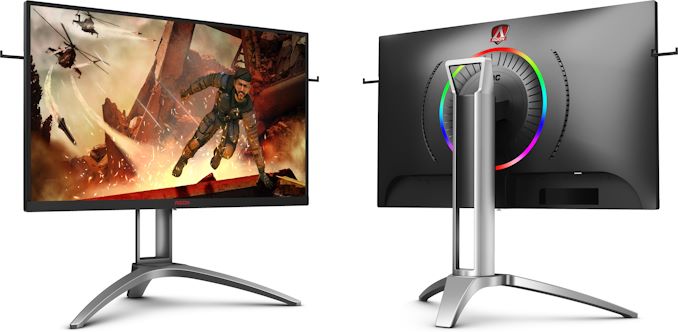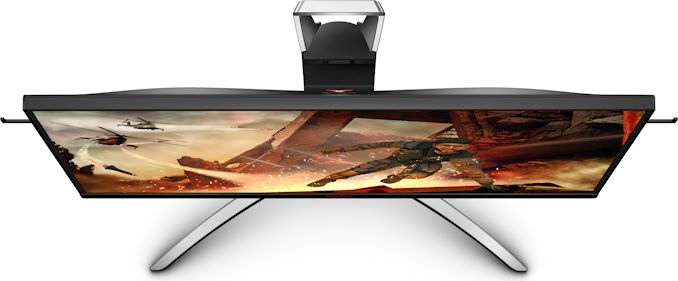AOC Reveals Agon AG273QX: A 27-Inch 165 Hz FreeSync 2 Monitor
by Anton Shilov on October 22, 2019 12:32 PM EST
AOC has introduced its new Agon-series 27-inch gaming display featuring a variable refresh rate of up to 165 Hz enabled by AMD’s FreeSync 2 technology. Like all Agon monitors, the AG273QX is aimed at demanding gamers and supports a multitude of features for the target audience, including special gaming modes, RGB lighting on the back, as well as G-Menu software for adjustments.
The AOG Agon AG273QX display uses an 8-bit 27-inch VA panel featuring a 2560×1440 resolution, 400 nits peak brightness, a 3000:1 static contrast ratio, a maximum refresh rate of 165Hz, a 1 ms MPRT response time, and 178°/178° viewing angles. Being an AMD FreeSync 2-certified monitor, the AG273QX fully supports a variable refresh rate (presumably with a 48 Hz to 165 Hz), direct-to-display tonemapping, low framerate compensation (LFC) mode, and can hit 90% of the DCI-P3 color gamut. The LCD also meets DisplayHDR 400 requirements with an HDR brightness of 400 nits and supports at least HDR10 transport. Unfortunately, AOC does not disclose how many backlighting zones its new monitor has.
When it comes to connectivity, the Agon AG273QX has a D-Sub, two DisplayPort 1.2, one miniDisplayPort, and two HDMI 2.0 connector. In addition, it has a quad-port USB 3.0 hub, and a headphone output, which is common for gaming displays these days. As an added bonus, the monitor has two 5 W speakers.
Since the product is designed primarily for gamers, the Agon AG273QX not only features a stand that can adjust height, tilt, swivel, and even pivot, but also a handle for easy carrying. Meanwhile, it also supports three pre-configured game modes (FPS, RTS, Racing) as well as three customizable game modes. Last but not least, it also comes with G-Menu software to make adjustments without using the OSD buttons.
AOC will start sales of its Agon AG273QX in November. In the UK the product will cost £439, so expect its MSRP in the US to be around $499.
| The AOC Agon AG273QX | |
| General Specifications | |
| Panel | 27" VA |
| Native Resolution | 2560 × 1440 |
| Maximum Refresh Rate | 165 Hz |
| Response Time | 1 ms MPRT |
| Brightness | 400 cd/m² (peak) |
| Contrast | 3000:1 |
| Backlighting | LED |
| Viewing Angles | 178°/178° horizontal/vertical |
| Curvature | - |
| Aspect Ratio | 16:9 |
| Color Gamut | 122% sRGB/BT.709 99% AdobeRGB 90% DCI-P3 |
| DisplayHDR Tier | 400 |
| Dynamic Refresh Rate Tech | AMD FreeSync 2 |
| Pixel Pitch | 0.2331 mm² |
| Pixel Density | 108 PPI |
| Inputs | 2 × DisplayPort 1.2 1 × Mini DisplayPort 1.2 1 × D-Sub 2 × HDMI 2.0 |
| Audio | 3.5 mm input and output |
| USB Hub | 4 × USB 3.0 Type-A connectors 2 × USB 3.0 Type-B input |
| Stand | Pivot: + Swivel: -3-/30 ° Tilt: 3.5/21.5 ° Height: 110mm VESA: 75x75 |
| MSRP | EU: ? UK: £439 US: ~$499 (not confirmed) |
Related Reading:
- GIGABYTE’s Aorus CV27Q Curved ‘Tactical’ Monitor: 165 Hz QHD With FreeSync 2
- AOC Agon 35-Inch 200 Hz Curved 3440x1440 HDR Gaming Monitor with FreeSync 2 or GSync
- AOC Announces AGON AG322QC4 32-Inch Curved LCD with FreeSync 2 & DisplayHDR 400
- HP's Omen X 27: A 240Hz QHD Monitor with FreeSync 2 HDR
- AOC’s Agon Monitors with 0.5ms Response Time & 240 Hz Refresh Now Available
Source: AOC













16 Comments
View All Comments
mrvco - Tuesday, October 22, 2019 - link
Glad to see some updated 1440p gaming displays coming to market. Looking forward to a review for this as well as Razer's new 27" 1440p IPS offering.p1esk - Tuesday, October 22, 2019 - link
Can we please get a high refresh rate 4k monitor that does not cost $2k? So tired of this low-res crap...bobeedee - Tuesday, October 22, 2019 - link
What he said (also 32")surt - Tuesday, October 22, 2019 - link
Yeah i do not at all understand people wanting any resolution under 4k today.ptmmac - Tuesday, October 22, 2019 - link
The additional cost for the required GPU in gaming is one reason. A 1440p monitor is a great compromise which allows for more eye candy like Ray tracing with out taxing the wallet or the power socket. Less power supply, ram and SSD are knock on costs that all add up over time.$900 for the computer and $300 for the monitor is a pretty good starting point for most of us. I have the power supply, case and SSD plus hard drive to handle anything currently on the market.
Ram ($75), Mother board ($75), CPU ($250) leaves $400 after accounting for sales tax. The options at that price point will not drive games on a 4K monitor.
Toss3 - Wednesday, October 23, 2019 - link
Now that Nvidia supports integer scaling this shouldn't be an issue anymore.nevcairiel - Wednesday, October 23, 2019 - link
If you use Integer scaling to compensate for a larger screen, you might as well get a screen with a lower resolution and avoid a lot of nonsense. Nevermind that Integer scaling has to work on even scales, so for a 4K screen that would mean you actually run on 1080p, instead of 1440p.nevcairiel - Wednesday, October 23, 2019 - link
Why would I intentionally reduce my performance by rendering more pixel when I cannot perceive a difference on 27" at usual viewing distances?27" 1440p is quite a sweet spot for me c urrently.
deil - Wednesday, October 23, 2019 - link
Well I want 27' as 32' will not fit my desk on height. and 2k on that size is better than 4k because of connectivity & price.Toss3 - Wednesday, October 23, 2019 - link
You must not have seen the Acer Nitro XV3 XV273 -> IPS UHD 144hz for under $1000.